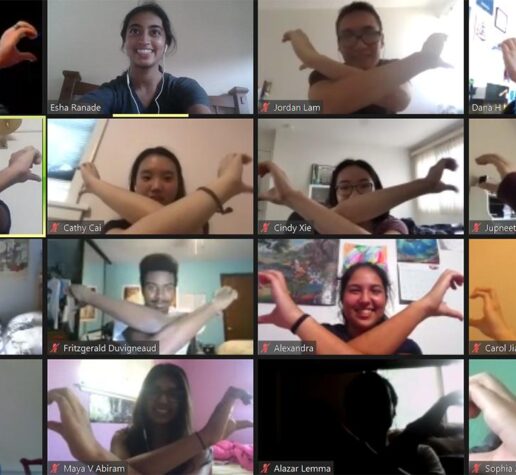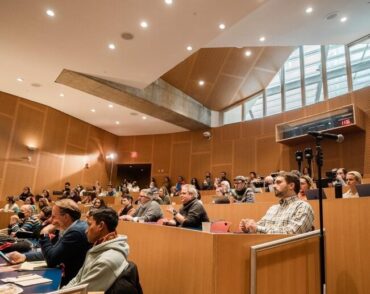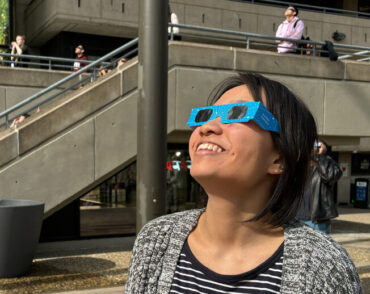
Bringing MIT magic to first-years everywhere
With creativity and hard work, the Institute is striving to provide the best possible experience for the Class of 2024.
“What I want to reiterate about this year is, it’s going to be strange. It is going to be a transition for the entire MIT community. But as 2024s, you are absolutely being prioritized in a number of ways, and there are so many people out there who are really, really excited to have you here and are ready to help you.”
That’s how MIT senior Danielle Grey-Stewart sought to reassure incoming students and their families at the July virtual town hall for first-years. She knows of what she speaks: as a member of the Undergraduate Association (UA) Committee on Covid-19, she and others have steadfastly represented undergraduates’ interests in conversations with the administration as it has navigated how to best continue MIT’s academic and research enterprises amidst a pandemic.
Plans to create an only-at-MIT experience for first-year students — who, for the fall semester at least, will be learning remotely — have been in the works for months. At the heart of many of these efforts, from academics to social life, is an emphasis on building personal connections among the Class of 2024 members — as well as with other students, faculty, staff, and alumni.
The Office of the First Year (OFY) kicked into high gear in the spring to build a foundation for the incoming class — well before OFY’s signature orientation week in late August. The OFY staff and 93 student orientation leaders (OLs) have engaged with first-years all summer through Slack channels, Zoom gatherings, friendly competitions among orientation teams, and social media. “We’ve been interacting with them 24/7 since the second week of May,” says Elizabeth Cogliano Young, associate dean and director of first-year advising.
Slack has been a particularly effective way to connect with the students, says Chelsea Truesdell, assistant dean of advising and new student programs. In addition to class-wide channels for general questions about advising, classes, and campus life, there are private channels for smaller orientation groups to get to know each other. “They can pretty much get instantaneous answers to their questions,” says Truesdell. “And that right-on-time response in Slack has introduced us to the students earlier. I feel like they know us better because we respond to them all the time, and that is something that has not happened before.”
OFY also launched a private virtual yearbook for 2024s, using the same platform that the Alumni Association uses. Over 800 first-years — nearly 75 percent of the class — have created a page for themselves. Using the yearbook, students can find others who live near them, and — in conjunction with the OFY Slack channels for specific courses, like 18.01 (Single Variable Calculus) — can form pset (problem set) or study groups for their geographic region.
Now in his third year as an OL, senior Richard Colwell is quite familiar with the inherent awkwardness incoming students feel when they first meet. In fact, he says, it may be slightly amplified this year, given that it’s virtual. But he’s noticed in his group that, after spending 10 weeks getting to know each other, first-year attendance during this year’s orientation has been higher than usual. “Maybe some of that is students realizing that even though this isn’t ideal, even though this is a bit awkward and it isn’t the semester we want, the students are each other’s best resource for making it through this unconventional fall,” he muses.
MIT’s first-year learning communities (FLCs) have also been busy this summer finding creative ways to build community among their first-year cohorts. In Terrascope, associate advisors (upper-level undergraduate students) have hosted a series of fun events, from online games and pet show-and-tell to baking and creating playlists. A book club has become a weekly staple, and the community discord server has been very popular.
The Experimental Study Group (ESG) welcomed each new student with a care package containing an ESG bandana, pen, and 50th anniversary booklet. Like Terrascope, ESG has offered a steady drumbeat of online activities, from meet-and-greet sessions to a six-week, self-study class led by physics lecturers Paulo Rebusco and Analia Barrantes, using the Media Lab’s Learning Creative Learning course.
In terms of academics, faculty and staff have given special consideration to adapting first-year classes for a virtual fall semester. Science core general Institute requirement (GIR) instructors are working to replicate traditional in-person elements that are central to the MIT experience, such as pset groups.
The Introductory Physics GIR (8.01) is a case in point. “Our big goal is to develop a community of students,” says Peter Dourmashkin, a physics senior lecturer who participated in the first-year town hall. “Psets are one of the great cultural things about MIT. We’re trying to recreate that peer-to-peer learning online through platforms that MIT students have been developing.” 8.01 will incorporate iPads and Apple Pencils provided by Information Systems and Technology — just two of the “flotilla of tools, learning platforms, trainings and support systems” that have been implemented to enhance remote instruction for all students, according to Krishna Rajagopal, dean for digital learning.
First-years can also find academic support in departments, programs, and offices throughout MIT. For example, the Office of Minority Education (OME) will offer small GIR study groups, facilitated by experienced upper-level students and graduate students. In addition, OME will host a daily virtual study lounge, the Talented Scholars Resource Room, where students can drop in and study with peers, or just hang out.
In a nod to an annual MIT tradition, the Mystery Hunt, the School of Humanities, Arts, and Social Sciences, and the Office of the Vice Chancellor are sponsoring a semester-long puzzle hunt called “Where in the Galaxy is Tim the Beaver?” Kate Weishaar, project coordinator in the first-year experience program, calls it a “one-of-a-kind quest to find new friends, inspiring professors, undiscovered interests, and, of course, Tim the Beaver.”
The idea came from history Professor Anne McCants, director of the Concourse First-Year Learning Community, with two primary goals: building community among first-years and allowing them to explore the humanities at MIT. Mystery Hunt student aficionados will help devise the puzzles, which will change every two weeks. And with each puzzle round, the first-years’ teams will be reshuffled, to help students meet new peers throughout the term.
The extended MIT family is doing its part to help first-years get to know each other and build their networks. In partnership with Office of the Vice Chancellor, the Alumni Association is planning a series of virtual dinners for the students in October and November hosted by alumni around the world. Some will be based on the students’ geographic region, while others will center on career-related themes, such as choosing a major.
Upper-level students are taking steps to make the Class of 2024’s virtual experience the best it can be. It’s been top-of-mind for Danielle Geathers, president of the UA, since she was elected in May. “One thing we really feared was that, how are you going to welcome first-years into this environment, into our virtual community?” she says.
To address those concerns, the UA plans to roll out a first-year program in late September to increase engagement with incoming students. Efforts will center on offering frequent UA events with officer meet-and-greets, creating stronger bonds between the senior class council and the first-year class council, and mentoring first-years. To increase visibility and generate buzz, they’ve created two videos, one released in July, and one to kick off Orientation. So far, nearly 70 first-years have reached out to express interest in getting involved.
Geathers believes that first-year voices have historically been underrepresented, and that now is an opportune time to address that. “It’s true that they have different interests, and they have things that affect them uniquely as a class, specifically this year. And although we can try to anticipate their interests, we don’t want to make any assumptions when we are representing their student voice to administrators. Now, more than ever, we have to depend on that engagement, because nobody knows what it’s like to do a fall virtual semester as a first-year.”


